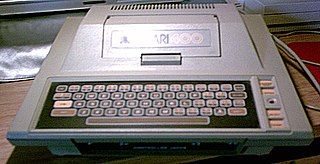User:AndersL/sandbox
 | |
| Type | Home computer |
|---|---|
| Release date | 1978 |
| Operating system | Atari BASIC |
| CPU | MOS Technology 6502 @ ? MHz |
| Memory | 8KB / 16KB - max 48 KB |
As soon as the Atari 2600 was released, the engineering team from Atari's Grass Valley Research Center (calling themselves Cyan Engineering), started work on its eventual replacement. They felt that the 2600 would have about a three year lifespan, and tried to limit themselves to those features that could be perfected by that time. What they ended up with was essentially a "corrected" version of the 2600, fixing its more obvious flaws.
The newer design would be faster than the 2600, have better graphics, and include much better sound hardware. Work on the chips for the new system continued throughout 1978, primarily focusing on the much-improved video hardware known as the CTIA (the 2600 used a chip known as the TIA).
However, at this point, the home computer revolution took off in the form of the Apple II family, Commodore PET and TRS-80. Ray Kassar, the new CEO of Atari, wanted the new chips to be used in a home computer to challenge Apple. Atari researched on what would be needed to produce a workable home computer of their own. This included support for character graphics (something the 2600 didn't support), some form of expansion for peripherals, the BASIC programming language, and a keyboard.
Management identified two sweet spots for the new computers, a low-end version known as Candy, and a higher-end machine known as Colleen (rumored to be named after attractive Atari staff). The primary difference between the two models was marketing; Atari marketed Colleen as a computer, Candy as a game machine (or hybrid game console). Colleen would include slots for memory and ROM, a second 8k cartridge slot, monitor output and a full keyboard, while Candy used a plastic "membrane keyboard" and internal slots (not user upgradable). Both machines were built like tanks with huge internal aluminum shields, originally to meet FCC rules for TV signals emitted in RF space (Part 15 Type I). Apple machines, without a RF modulator, didn't need to meet those requirements (the first model of the TRS-80 actually never met that FCC spec).
Atari had originally intended to port Microsoft BASIC to the machine, as had most other vendors, intending to supply it on an 8k ROM cartridge. However the existing 6502 version from Microsoft was 12k, and all of Atari's attempts to pare it down failed. Eventually they farmed out the work to a local consulting firm, who recommended writing their own version from scratch, which was eventually delivered as ATARI BASIC.
The machines were announced in December 1978 as the 400 and 800, although they weren't widely available until November 1979. The names originally referred to the amount of memory, 4K RAM in the 400 and 8K in the 800. However by the time they were released the prices on RAM had started to fall, so the machines were instead released with 8K and 16K respectively.
Due to the FCC restrictions, the 400/800 couldn't allow slots like those found on the Apple II computers. Instead, they created a proprietary, expensive serial-based interface called SIO (Serial Input/Output). All external devices were connected using this interface (cassette drive, disk drive, interface box) adding to the cost of ownership. On the 800, the internal slots were reserved for ROM and memory modules. Originally the machines shipped with 16k, but as prices continued to fall Atari eventually supplied the machines fully expanded to 48k, using up all the slots.
A few companies made RAM modules for the Atari 800. One company made a module which added an 80-column display system and 16k of RAM so you could remove one of the Atari-supplied cards without losing memory. Overheating problems with the memory modules eventually led Atari to remove the casings on the memory modules, leaving them as "bare" boards. Later, the expansion cover was held down with screws instead of latches.
The Atari 800 sold respectably, but not nearly as well as the Apple machines. The crippling of the 400 only confused buyers, and as the 400 outsold the 800 by some margin, developers were generally loath to use the 800-only features like the second cartridge slot.
Peripherals
[edit]Atari's peripherals were named after the machines they were intended to be used with, so in general they have names like "410" and "1050". All of them used the proprietary SIO port, which allowed them to be daisy chained together into a single string; a method also used in Commodore's home computers from the VIC-20 onwards. These "intelligent" peripherials were more expensive than the standard IBM PC devices, which did not need the added SIO electronics.
400/800 series
[edit]- 410 tape drive, 600 bit/s on cassettes
- 810 5¼" floppy disk, single-density single-sided, 90 KiB
- 815 dual 5¼" floppy disks, double-density single-sided, 180 KiB (only small numbers produced)
- 820 printer, 40-column dot matrix on adding machine paper
- 822 printer, 40-column thermal on slightly wider paper
- 825 printer, 80-column dot matrix (Centronics 737)
- 830 300-baud modem, using an acoustic coupler, used RS-232 so required an 850 (Novation CAT)
- 835 300-baud modem, direct connect, basic Hayes compatible with SIO interface
- 850 expansion system, included four RS-232 ports and one Centronics parallel port
- CX-85 Numerical Keypad, external keypad that plugs into the joystick ports.
